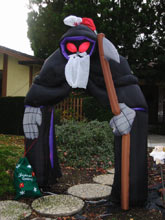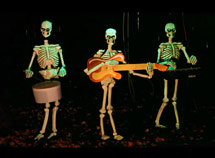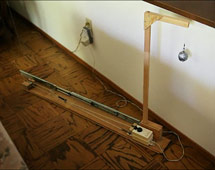
Handy Links
SLAC News Center
SLAC Today
- Subscribe
- Archives: Feb 2006-May 20, 2011
- Archives: May 23, 2011 and later
- Submit Feedback or Story Ideas
- About SLAC Today
SLAC News
Lab News
- Interactions
- Lightsources.org
- ILC NewsLine
- Int'l Science Grid This Week
- Fermilab Today
- Berkeley Lab News
- @brookhaven TODAY
- DOE Pulse
- CERN Courier
- DESY inForm
- US / LHC
SLAC Links
- Emergency
- Safety
- Policy Repository
- Site Entry Form

- Site Maps
- M & O Review
- Computing Status & Calendar
- SLAC Colloquium
- SLACspeak
- SLACspace
- SLAC Logo
- Café Menu
- Flea Market
- Web E-mail
- Marguerite Shuttle
- Discount Commuter Passes
-
Award Reporting Form
- SPIRES
- SciDoc
- Activity Groups
- Library
Stanford
Around the Bay
People: Tom Himel's Holiday Haunts
SLAC physicist Tom Himel's largest Christmas decoration looks like something out of Tim Burton's stop-action film The Nightmare Before Christmas. In the movie, ghouls and goblins from Halloween Town discover a portal to Christmas Town and try to join the Christmas festivities. At the Himel house during the holiday season, "The Grinch"—a giant inflated grim reaper adorned with a Santa hat, beard and a green sack—stands across the front path. The Grinch made its first appearance when Himel began hosting the Accelerator Research Department's holiday party, and has stuck around ever since.
"To make sure people can find the house, I dressed up the grim reaper as Santa," Himel said. But ask where the reaper-turned-Santa comes from, and Himel will tell you that it is simply a "remnant" of his family's Halloween display—a ghoul from Halloween Town that made the journey to Christmas Town and is trying to fit in.
For more than two decades, the Himel family has put on quite the show at Halloween time. More than twenty years ago, they pulled up a hedge, leaving four holes in their front yard in late October. The family turned the four holes into a basic Halloween display: four graves with wooden tombstones. That year, 50 trick-or-treaters came to the house.
The display has grown and become more popular every year since. "Himel's Happy Haunts" now includes an animated skeleton rock band named The Skeletones, a witch stirring a smoking cauldron, flying bats, a zombie rising from its tomb, grim reapers and more. This video shows each portion the display, which brought a record 587 trick-or-treaters to the Himel house this past Halloween.
"Typically, every year we add something," Himel said. "Right after Halloween, my wife, daughter and I brainstorm for the next year. If it is technically difficult, I start working on it about mid-year."
The overall display is a true collaboration. "My wife and daughter are the artistic direction, I do the technical design," Himel said. The Skeletones were originally his wife and daughter's idea. Himel spent months figuring out how to make the band members move in time to the music. When he told his family he knew how to do it, his wife and daughter informed him that they had not intended the band to be animated. But Himel could not be stopped at this point. And once the display was constructed, the artistic director took over again. "My wife added the idea that the drummer's head should bob up and down with the music," Himel said.
The Skeletones and other displays' motion and soundtracks require some coordination. Judging from Himel's work on control systems at SLAC—including the control system for the PEP-II storage ring and more recently upgrades to the linac's control system for the Linac Coherent Light Source—he has plenty of general computer know-how to piece together Himel's Happy Haunts.
The Happy Haunts "control system" uses two computers and many peripheral electronic components. For example, an indoor computer with MIDI—or Musical Instrument Digital Interface—hardware and software controls the Skeletones. The Himel's downloaded MIDI music from the Web and edited it to add percussion tracks that feed out to effectors to control movements of the Skeletones. The computer is connected to a MIDI interface originally meant to control a percussion instrument, but it actually controls pneumatic solenoids, switches for routing air to pressure-driven devices. An air compressor in the house has a hose which leads out a window to provide pressure for the display. The air switched by the solenoids runs pneumatic cylinders, which move teeter-totters connected to strings that move the heads, arms and feet of the Skeletones like a puppeteer moves marionettes. This complex system is what makes the skeletons play a keyboard, strum a guitar and beat a drum in time to the music.
And if that is not enough work, each display is done differently at the Himel household. The witch's cauldron contains ultrasonic foggers to create the illusion of smoke. The foggers must sit underwater, so Himel made a custom-sized bowl to fit within the cauldron and hold the water. He fit the bowl by heating plastic and bending it into a cylinder, a technique he learned from seeing scintillation counter light guides manufactured at SLAC. A motor turns the bowl, making it look as though the witch is stirring the cauldron. For more background information, look for the "behind the scenes" video below the Himel's overview video (link above).
Kids flock to the house to see the display and Himel said that while some children are a bit timid, few cry. "Most of our stuff is supposed to be entertaining, not scary," Himel said. In the end, it's all about enjoying the holiday. "We have a lot of fun."
—Lauren Knoche
SLAC Today, December 16, 2009


